Este post também está disponível em:
Português
English
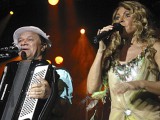
José Domingos de Morais (Garanhuns, February 12, 1941), known as Dominguinhos, is a Brazilian instrumentalist, singer and songwriter.
Dominguinhos was an excellent singing, had as masters names like Luiz Gonzaga and Orlando Silveira. His musical background includes influences from baião, bossa nova, choro, forró, xote, jazz etc.
Luiz Gonzaga set the tone and Dominguinhos followed the melody on the accordion.
More than learning, the disciple innovated the master’s art. Dominguinhos lent the accordion new and different accents.
He did not abandon the baião of his godfather, but he also did not stop playing on other beaches of Brazilian music.
Dominguinhos’ work is further proof that accents or origins matter little when it comes to making music.
In the universe of sounds and rhythms what really counts is sensitivity, responsible for emotion and talent, capable of transforming ideas and concepts into works of art.


Biografia de Dominguinhos

Dominguinhos no íncio cantando

Dominguinhos estilo musical

Forró com Luis Gonzaga e Dominguinhos
These are the most constant ingredients in the trajectory of the Pernambucan of Garanhuns José Domingos de Morais, Dominguinhos, having as background a great talent, they make up the picture of the life of one of the important Brazilian artists of today.
Biography of Dominguinhos
Neném do Acordeon
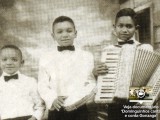
12/2/1941 – José Domingos de Morais is born in Garanhuns, in the agreste of Pernambuco. He is the son of Master Chicão, player and tuner of eight-bass accordions (like Januário, Gonzaga’s father).
I was born with a bunch of siblings, there were 16 of us, my mother, my father. At that time everything was very difficult, a bit like nowadays, but today we have more things”.
As a child, he plays triangle with his brothers in the group Os Três Pinguins, formed by Moraes (accordion) and Valdomiro (zabumba). Neném do Acordeon is his childhood nickname.
1949 – At the age of 7, he meets Luiz Gonzaga while playing in front of the hotel where he was staying, in Garanhuns. The King of Baião promises the boy an accordion as a gift if one day he went to Rio de Janeiro.
Dominguinhos is born
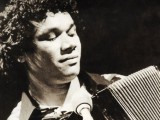
1954 – Moves to Rio accompanied by his father and one of his brothers. Settled in the suburb of Nilópolis, learns other styles to play in nightclubs of the city, especially the chorinho.
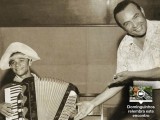
1957 – At 16, he is sponsored by Gonzaga, who calls him his ‘artistic heir’. Gonzagão would later give him the nickname that would make him famous in Brazil.
In the same year, he makes his first professional recording when he plays the accordion in the song ‘Moça de feira’, on an album by Luiz Gonzaga.
Trio Nordestino and Anastácia
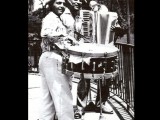
1958 – At 17, he marries Janete, his first wife. Dominguinhis had with her the children Mauro and Madeleine Trio Nordestino and Anastácia
They used to say that Gonzaga has the voice of a cracked cane. That black man, in a leather hat, in espadrilles, in a gibbon, playing the accordion, was an affront dancing xaxado, all those things”.
1958 – Formed, along with Zito Borborema and Miudinho, the forró group Trio Nordestino. In the following years, he becomes interested in other genres, such as samba, gafieira and bolero.
1965 – Dominguinhos is invited by Pedro Sertanejo to record on the Cantagalo label, a record aimed at the northeastern immigrants living in Rio de Janeiro.
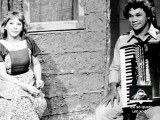
1967 – Back to xotes and baiões, he joins Gonzagão’s tour in the northeast, dividing himself between accordion player and driver (Dominguinhos, by the way, was afraid of airplanes).
On this tour, he met the Pernambuco singer Anastácia, his future wife and co-author of more than 200 songs.
Xodó baiano
I think a lot of people take a shine to me, but there are a lot of people playing. I am now a veteran of the instrument, so everyone respects me, everyone has affection”
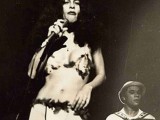
1972 – At the invitation of businessman Guilherme Araújo, he accompanies Gal Costa in the show ‘India’. The following year, Gil records ‘Eu só quero um xodó’, a hit that would later gain more than 250 re-recordings.
1975 – Participates in the tour of ‘Refazenda’ by Gilberto Gil, who also records ‘Tenho sede’. Starts to collaborate more frequently with the universe of MPB (see photo with Nara Leão). In 1979, composes with the poet Manduka ‘Quem me levará sou eu’, winner of the TV Tupi Festival.
1985 – & nbsp; Places two songs in the soap opera ‘Roque Santeiro’: ‘Back to my coziness’, and ‘This here is too good’, signed with Nando Cordel.
Invasion of forró universitário

1990 – During the whole decade, Dominguinhos released one album a year. During these ten years, he was critical of the university and electronic forró – calling the latter ‘disposable’.
1997 – He signs the songs of the movie ‘O cangaceiro’, by Anibal Massaini Neto. He also participates singing the songs of Zé do Norte, present in the original feature film of 1953.
1999 – Ten years after the death of Luiz Gonzaga, records the album ‘Você vai ver o que é bom’, which brings an unpublished song by the composer Zé Dantas (partner of Gonzagão).
Dominguinhos (1941-2013) was a Brazilian musician. Singer, accordion player and composer, he partnered with Gilberto Gil, Nando Cordel and Chico Buarque, Anastácia, among others.
Dominguinhos (1941–2013) was born in Garanhuns, Pernambuco, on February 12, 1941. Son of Master Chicão, an eight-bass bellows player and tuner, he began his artistic career in childhood, when he formed a trio with his two brothers. His instrument was the pandeiro, and the trio performed at free fairs, botequins and hotel doors.
In 1948, playing at a hotel door, he was heard by Luiz Gonzaga, who was delighted with the boys’ skill and gave them his address in Rio de Janeiro. In 1954, together with his family, in a pau-de-arara truck, he went to Rio de Janeiro. As soon as they arrived in the municipality of Nilópolis, Luiz Gonzaga became his godfather and presented him with an accordion.
Under the stage name Neném do acordeon, he began playing in bars, steakhouses, casinos and nightclubs. In 1967, he joined Rádio Nacional, the year he recorded his first album. He was invited to recordings and concerts by famous singers, including Gal Costa, Gilberto Gil, Caetano Veloso and Maria Betânia.
Dominguinhos had as a partner the singer and composer Anastácia, who wrote the lyrics for 210 songs composed by him.
He partnered with Chico Buarque, in the song “Tantas Palavras”, with Nando Cordel, in “De volta pro meu aconchego” and “Isso aqui tá bom demais”, with Gilberto Gil, in the songs “Lamento Sertanejo and Abri a porta”, among others. With several albums recorded, with his characteristic leather hat, Dominguinhos performed throughout the country, playing with his accordion, forró, typical music from the Northeast of Brazil.
On December 17, 2012, Dominguinhos was admitted to the Santa Joana Hospital in Recife with a respiratory infection and cardiac arrhythmia. On January 15, at the request of his family, he was transferred to the Sírio Libanês Hospital in São Paulo, where he remained in a coma after two cardiac arrests.
Dominguinhos died on July 23, 2013, in São Paulo. His burial took place at the Morada da Paz cemetery, in the municipality of Paulista, in the Metropolitan Region of Recife.
To meet a request from Dominguinhos, who in an interview given to radio broadcaster Geraldo Freire, from Rádio Jornal do Comércio, in the city of Recife, expressed the desire to be buried in the municipality where he was born, the singer’s body was transferred to Garanhuns, on July 26, 2013, and buried in the São Miguel cemetery.
Biography of Dominguinhos
Bahia.ws – Tourism and Travel Guide of Bahia, Salvador and Northeast Brazil



















